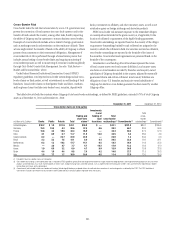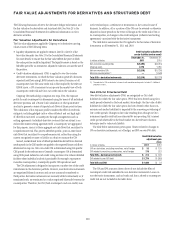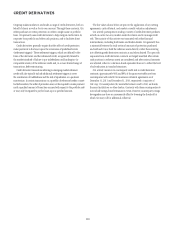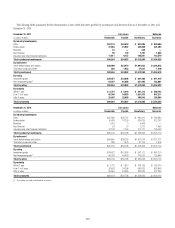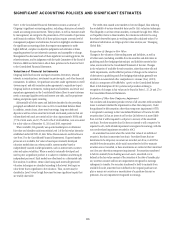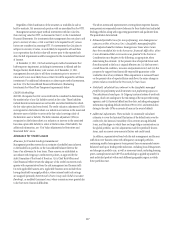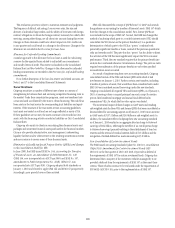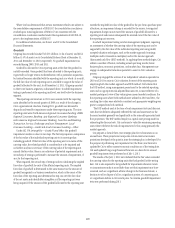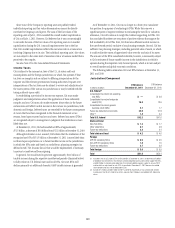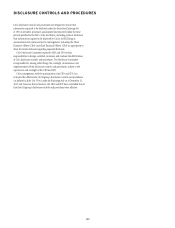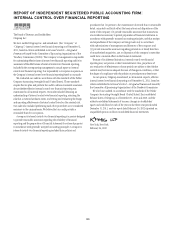Citibank 2011 Annual Report Download - page 143
Download and view the complete annual report
Please find page 143 of the 2011 Citibank annual report below. You can navigate through the pages in the report by either clicking on the pages listed below, or by using the keyword search tool below to find specific information within the annual report.121
The U.S. federal consolidated tax return NOL carry-forward component
of the DTAs of $3.8 billion at December 31, 2010 was utilized in 2011. For the
reasons discussed herein, Citi believes the U.S. federal and New York state and
city NOL carryforward period of 20 years provides enough time to fully utilize
the DTAs pertaining to the existing NOL carryforwards and any NOL that
would be created by the reversal of the future net deductions that have not yet
been taken on a tax return.
Because the U.S. federal consolidated tax return NOL carryforward has
been utilized, Citi can begin to utilize its foreign tax credit (FTC) and general
business credit (GBC) carryforwards. The U.S. FTC carryforward period is
10 years. Utilization of foreign tax credits in any year is restricted to 35% of
foreign source taxable income in that year. However, overall domestic losses
that Citi has incurred of approximately $56 billion as of December 31, 2011
are allowed to be reclassified as foreign source income to the extent of 50%
of domestic source income produced in subsequent years, and such resulting
foreign source income would in fact be sufficient to cover the foreign tax
credits being carried forward. As such, Citi believes the foreign source taxable
income limitation will not be an impediment to the foreign tax credit
carryforward usage as long as Citi can generate sufficient domestic taxable
income within the 10-year carryforward period.
Regarding the estimate of future taxable income, Citi has projected its
pretax earnings, predominantly based upon the “core” businesses that Citi
intends to conduct going forward. These “core” businesses have produced
steady and strong earnings in the past. Citi believes that it will generate
sufficient pretax earnings within the 10-year carryforward period referenced
above to be able to fully utilize the foreign tax credit carryforward, in
addition to any foreign tax credits produced in such period.
As mentioned above, Citi has examined tax planning strategies available
to it in accordance with ASC 740 that would be employed, if necessary, to
prevent a carryforward from expiring and to accelerate the usage of its
carryforwards. These strategies include repatriating low-taxed foreign source
earnings for which an assertion that the earnings have been indefinitely
reinvested has not been made, accelerating U.S. taxable income into or
deferring U.S. tax deductions out of the latter years of the carryforward
period (e.g., selling appreciated intangible assets and electing straight-line
depreciation), accelerating deductible temporary differences outside the
U.S., holding onto available-for-sale debt securities with losses until they
mature and selling certain assets that produce tax-exempt income, while
purchasing assets that produce fully taxable income. In addition, the sale
or restructuring of certain businesses can produce significant U.S. taxable
income within the relevant carryforward periods.
As previously disclosed, Citi’s ability to utilize its DTAs to offset future
taxable income may be significantly limited if Citi experiences an
“ownership change,” as defined in Section 382 of the Internal Revenue Code
of 1986, as amended (Code). Generally, an ownership change will occur if
there is a cumulative change in Citi’s ownership by “5-percent shareholders”
(as defined in the Code) that exceeds 50 percentage points over a rolling
three-year period. Any limitation on Citi’s ability to utilize its DTAs arising
from an ownership change under Section 382 will depend on the value of
Citi’s stock at the time of the ownership change.
See Note 10 to the Consolidated Financial Statements for a further
description of Citi’s tax provision and related income tax assets and liabilities.
Approximately $11 billion of the net DTAs was included in Tier 1 Common
and Tier 1 Capital as of December 31, 2011.
Litigation Accruals
See the discussion in Note 29 to the Consolidated Financial Statements for
information regarding Citi’s policies on establishing accruals for legal and
regulatory claims.
Accounting Changes and Future Application of
Accounting Standards
See Note 1 to the Consolidated Financial Statements for a discussion of
“Accounting Changes” and the “Future Application of Accounting Standards.”


